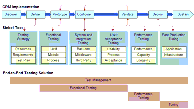| Bookshelf Home | Contents | Index | PDF |   |
|
Developing and Deploying Siebel Business Applications > Introducing the Business Case > Introduction to Application Software Testing > Siebel eRoadmap Implementation MethodologyThe Siebel eRoadmap implementation methodology accelerates project implementations by focusing on the key strategic and tactical areas that must be addressed to maximize the customer's return on investment, while minimizing their business risk to promote a successful completion of a Siebel project. The Siebel implementation is composed of activities logically grouped into eight distinct eRoadmap stages to make sure proper project management and control techniques are used during the life cycle of a project. These stages (illustrated in Figure 2) are iterative in nature. Testing is an end-to-end process that begins when you start to configure the Siebel application. The first stage is the development of a testing strategy by the testing team to define environmental simulation requirements and testing approaches, establish priorities, and define and create proper functional and load test scripts. The output of this stage is a comprehensive Test Plan. As mentioned earlier, functional testing begins when prototyping begins and continues throughout the configuration of the Siebel application as developers test each unit they configure. Tested units are then moved into the testing environment, where the appropriate units are combined to form a corresponding module. The test team then verifies whether or not the module functions correctly (for example, returns the correct value), has the correct layout (for example, drop-down menus and text fields), and has the correct interface. After validating a module, functional testing continues using business processes and scenarios to verify whether or not all modules work together as required. The next stage of functional testing, System and Integration testing, is validation that the Siebel application operates with other applications and interfaces. Test the Siebel application in a test environment that allows the Siebel application to interoperate with the other required applications (such as CTI, load balancer, and middleware). User Acceptance testing (UAT) consists of testing the Siebel application using the appropriate business owners and end users. When performing UAT, make sure that you have users who are familiar with the existing business processes. Performance testing provides an assessment of whether or not an infrastructure performs and scales to your requirements. This phase requires an image of the full database and all interfaces with the Siebel application (such as CTI, middleware, and email). This must be conducted in an environment that has realistic test data. The first step is to establish a benchmark of performance through the completion of a performance test. Next, complete a capacity test by adding users until you reach the number of users expected to use the application over its life. Finally, execute the test over an extended period of time (longevity test) to determine durability of an application as well as capture any defects that become visible over time. |
  |
| Developing and Deploying Siebel Business Applications | Copyright © 2006, Oracle. All rights reserved. | |
